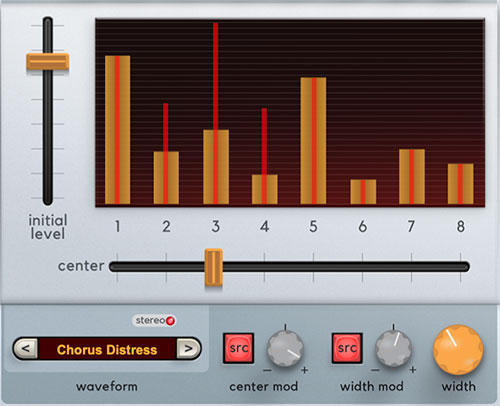
Consisting of the Center, Width, and Initial Level sliders and their dedicated mod bus controls, you can think of the interpolating scanner as a powerful, highly modulatable eight-channel mixer for harmonics that operates like a DJ crossfader combined with a parametric equalizer. It's the key to creating Harmonia's signature radical timbral morphing, and despite its heady-sounding name, the interpolating scanner is super easy to use.
Center- Sets the overall mix position. We'll demonstrate by example:
Click the New button at the top left of Harmonia's purple menu strip.
Select a simple waveform - we'll use Sine.
Set Initial Level to full, and Width to zero.
Now move the Center control while holding a key. As the Center control is moved, Harmonia sweeps through the first eight pitches of the harmonic series. You may notice that the harmonics abruptly shift from one to the next. This is because the Width control is at zero (i.e., no interpolation); at any setting greater than zero, harmonics will transition smoothly.
Center is the interpolating scanner's most important control. You'll likely find yourself swinging it back and forth like one does with an analog synth's filter cutoff control, and Center is an ideal candidate for a number of modulation sources - hence the dedicated mod bus.
Center Mod Source (SRC) and attenuverter- Allows modulation of the Center slider control from numerous sources. To set up modulation, click the SRC button, select a source, then set the amount of mod with the Center Mod attenuverter knob. The knob can be turned clockwise from center for positive modulation or counterclockwise from center for negative modulation. (Hence the attenuverter name: attenuator+inverter.)
Width and Width Mod controls- The Width knob sets the relative volume of neighboring harmonics, from a single harmonic up to all eight at once.
Use the same settings as the example above and set the Center slider to about 50% (between 4 and 5). Now hold a key down and slowly turn up the Width knob. Cool, right?
If the Width knob is set to zero, a single harmonic is heard, and harmonics instantly snap from one to the next; this allows creation of stepped sequencer-like melodies. At settings greater than zero, harmonics will smoothly transition from one to the next - that's the "interpolating" part of interpolating scanner (while "scanner" refers to the movement across the harmonics).
Width Mod Source (SRC) and attenuverter- Allows modulation of the Width knob from numerous sources. To set up modulation, click the SRC button, select a source, then set the amount of mod with the Width Mod attenuverter knob. The knob can be turned clockwise from center for positive modulation or counterclockwise from center for negative modulation.
The dedicated Center Mod and Width Mod sections are provided to make the creation of animated sounds fast and easy, but Center and Width are also included as mod destinations in the Mod Matrix section. This allows multiple sources to simultaneously modulate Center and Mod.
And finally... keep in mind that the fixed Harmonic Level bars are freely combinable with the Center and Width Interpolated Scanner controls. When combined with modulation, the results can often make one oscillator sound like two or even three independent oscillators. We'll further explore these kinds of programming tricks later on.
Initial Level- This one can be a little hard to wrap your head around, but the idea is that the Center control horizontally moves a fixed "wave" of voltage that pushes up the various harmonic levels (with the wave width set via the Width knob). With that in mind, Initial Level sets the height of the wave.
Depending on the type sound you'd like to make, you may or may not want to make use of the initial level "wave." For example, you might want to create a sound where each harmonic is at a different fixed level, set Initial Level to zero, and simply adjusting each Harmonic Level Bar to the desired volume. Incidentally, this is how basic additive synthesis is done, and there are plenty of interesting tones to be found this way.
Conversely, to create animated, moving tonalities by modulating the Center and Width controls, you'd want to set all Harmonic Level bars to zero, Initial Level to a high setting, and then set the Center and Width controls (and their mod sources) as desired.
Of course, both both methods can be combined to create endless combinations of fixed and dynamically modulating harmonic levels.